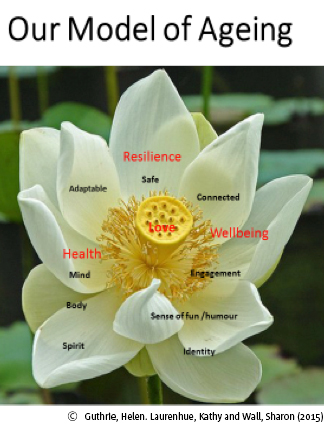What do you get when you add an architect, an educational strategist and a nurse and combined decades of time working in the aged care environment together? Oops!!!! forgot something. Let’s add the shared values of a committed belief in love, caring and empathy being part of the ageing experience for all people, across the globe.
Well, in short, you get respected colleagues who become loved friends, a lot of reflection, a lot of sharing, a lot of talking and now a lot of action.
My friend Helen Guthrie (an Australian living in Chicago) and my friend Kathy Laurenhue (an American, living in Florida) and I have a long and shared history of working in ageing. We have collaborated on several projects and have maintained a stimulating and mutually respectful communication about many things over many years.
One of our increasing and shared experiences and one that continues to influence our work daily is the lack of caring elements in some ageing and aged care environments.
We talk and debrief often (thankyou Skype 🙂 ) and felt quite passionately that we needed to put our money where our mouth was in terms of trying to make a difference to the quality of life of older people by ensuring that love, compassion and empathy became the norm.
We felt that there were tools that older people both required and deserved to enhance their ageing experience and sought to explore what our combined experiences could add to that mix.
Seeking a place to start, we attempted to put together a desirable (albeit hypothetical) model of ageing which reflected our research, our values and most importantly (and ultimately) reflected the views and thoughts of older people themselves.
The integral components (we refer to them as tenants of ageing) of this model are Health (including Mind Body and Spirit), Resilience (which includes Adaptability, Being Safe and being Connected) and Wellbeing (including Engagement, Sense of Fun /Humour and Identity). Importantly, in our model, in the centre we placed LOVE.
We placed these tenants within the safe petals of a lotus flower because of the powerful analogies and symbolism of ageing contained within.
The Ancient Egyptians the lotus flower came to symbolize the sun and the creation and life and death; In Hinduism, the lotus flower meaning is associated with beauty, fertility, prosperity, spirituality, and eternity; In Buddhism, the lotus is known to be associated with purity, spiritual awakening and faithfulness.
But importantly the lotus speaks of incredible resilience being a flower who sits on the murky bottom of the pond with amazing petals reaching up to the heavens …resilience indeed.

We have used this model to engage meaningfully with older people in Australia, New Zealand and the Unites States of America and have been very humbled by the responses and dialogue which continue to influence us all so meaningfully. I look forward to sharing some of these insights with you over time – stay tuned.
